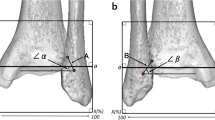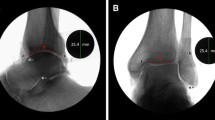Abstract
Objective
The diagnosis of ankle syndesmosis injuries is made by various imaging techniques. The present study was undertaken to examine whether the three-dimensional reconstruction of axial CT images and calculation of the volume of tibiofibular joint space enhances the sensitivity of diastases diagnoses or not.
Design
Six adult cadaveric ankle specimens were used for spiral CT-scan assessment of tibiofibular syndesmosis. After the specimens were dissected, external fixation was performed and diastases of 1, 2, and 3 mm was simulated by a precalibrated device. Helical CT scans were obtained with 1.0-mm slice thickness. The data was transferred to the computer software AcquariusNET. Then the contours of the tibiofibular syndesmosis joint space were outlined on each axial CT slice and the collection of these slices were stacked using the computer software AutoCAD 2005, according to the spatial arrangement and geometrical coordinates between each slice, to produce a three-dimensional reconstruction of the joint space. The area of each slice and the volume of the entire tibiofibular joint space were calculated. The tibiofibular joint space at the 10th-mm slice level was also measured on axial CT scan images at normal, 1, 2 and 3-mm joint space diastases.
Results
The three-dimensional volume-rendering of the tibiofibular syndesmosis joint space from the spiral CT data demonstrated the shape of the joint space and has been found to be a sensitive method for calculating joint space volume. We found that, from normal to 1 mm, a 1-mm diastasis increases approximately 43% of the joint space volume, while from 1 to 3 mm, there is about a 20% increase for each 1-mm increase.
Conclusions
Volume calculation using this method can be performed in cases of syndesmotic instability after ankle injuries and for preoperative and postoperative evaluation of the integrity of the tibiofibular syndesmosis.





Similar content being viewed by others
References
Williams A, Davies MS. Ankle and Foot. In: Standring S, editor. Gray’s anatomy. London: Churchill Livingstone; 2005. p. 1525
Romanes GJ. Cunningham’s textbook of anatomy. London: Oxford University Press; 1972. p. 247–249
Gumann G. Ankle Fractures. In: Scurran BL, editor. Foot and ankle trauma. Churchill Livingstone; 1990. p. 579–625
Snedden MH, Shea JP. Diastasis with low distal fibula fractures: an anatomic rationale. Clin Orthop Relat Res 2001;382:197–205
Boytim MJ, Fischer DA, Neumann L. Syndesmotic ankle sprains. Am J Sports Med 1991;19:294–298
Pankovich AM. Fractures of the fibula at the distal tibiofibular syndesmosis. Clin Orthop Relat Res 1979;143:138–147
Muratli HH, Bicimoglu A, Celebi L, Boyacigil S, Damgaci L, Tabak AY. Magnetic resonance arthrographic evaluation of syndesmotic diastasis in ankle fractures. Arch Orthop Trauma Surg 2005;125(4):222–227
Ebraheim NA, Lu J, Yang H, Mekhail AO, Yeasting RA. Radiographic and CT evaluation of tibiofibular syndesmotic diastasis: a cadaver study. Foot Ankle 1997;18(11):693–698
Brage ME, Bennett CR, Whitehurst JB, Getty PJ, Toledano A. Observer reliability in ankle radiographic measurements. Foot Ankle Int 1997;18(6):324–329
Takao M, Ochi M, Oae K, Naito K, Uchio Y. Diagnosis of a tear of the tibiofibular syndesmosis: the role of arthroscopy of the ankle. J Bone Joint Surg Br 2003;85(3):324–329
Bozic KJ, Jaramillo D, DiCanzio J, Zurakowski D, Kasser J. Radiographic appearance of the normal distal tibiofibular syndesmosis in children. J Pediatr Orthop 1999;19(1):14–21
Harper MC, Keller TS. A radiographic evaluation of the tibiofibular syndesmosis. Foot Ankle Int 1989;10(3):156–160
Beumer A, Van Hemert WLW, Niesing R, et al. Radiologic measurement of the distal tibiofibular syndesmosis has limited use. Clin Orthop Related Res 2004;423:227–234
Ebraheim NA, Mekhail AO, Gargasz SS. Ankle fractures involving the fibula proximal to the distal tibiofibular syndesmosis. Foot Ankle Int 1997;18(8):513–521
Harper MC. An anatomic and radiographic investigation of the tibiofibular clear space. Foot Ankle 1993;14(8):455–458
Beumer AB, Swiersta A. The influence of ankle positioning on the radiography of the distal tibial tubercles. Surg Radiol Anat 2003;25:446–450
Ramsey PL, Hamilton W. Changes in tibiotalar area of contact caused by lateral talar shift. J Bone Joint Surg 1976;58A:356–357
Harper MC. Talar shift. The stabilizing role of the medial, lateral, and posterior ankle structures. Clin Orthop 1990;257:177–183
Ebraheim NA, Elgafy H, Panadilam T. Syndesmotic disruption in low fibular fractures associated with deltoid ligament injury. Clin Orthop Related Res 2003;409:260–267
Oae K, Takao M, Naito K, et al. Injury of the tibiofibular syndesmosis: value of MR imaging for diagnosis. Radiology 2003;227:155–161
Brown KW, Morrison WB, Schweitzer ME, et al. MRI findings associated with distal tibiofibular syndesmosis injury. AJR 2004;182:131–136
Pelc JS, Beaulieu CF. Volume rendering of tendon-bone relationships using unenhanced CT. AJR 2001;176:973–977
Calhoun PS, Kuszyk BS, Heath DG, Carley JC, Fishman EK. Three-dimensional volume rendering of spiral CT data: theory and method. Radiographics 1999;19:745–764
Choplin RH, Buckwalter KA, Rydberg J, Farber JM. CT with 3D rendering of the tendons of the foot and ankle: technique, normal anatomy, and disease. Radiographics 2004;24(2):343–356
Sha Y, Zhang SX, Liu ZJ, et al. Computerized 3D reconstructions of the ligaments of the lateral aspect of ankle and subtalar joints. Sur Radiol Anat 2001;23:111–114
Woolson ST, Dev P, Fellingham LL, Vassiliadis A. Three-dimensional imaging of the ankle joint from computerized tomography. Foot Ankle 1985;6(1):2–6
Pretorius ES, Fishman EK. Volume-rendered three-dimensional spiral CT: musculosceletal applications. Radiographics 1999;19:1143–1160
Acknowledgement
We are thankful to Mr. Arif B. Taser for his valuable assistance in generating the three-dimensional model using AutoCAD computer software.
Author information
Authors and Affiliations
Corresponding author
Additional information
This study was approved by the Institutional Review Board. The authors did not receive grants or outside funding in support of their research or preparation of this manuscript. They did not receive payments or other benefits or a commitment or agreement to provide such benefits from a commercial entity. No commercial entity paid or directed, or agreed to pay or direct, any benefits to any research fund, foundation, educational institution, or other charitable or nonprofit organization with which the authors are affiliated or associated.
Rights and permissions
About this article
Cite this article
Taser, F., Shafiq, Q. & Ebraheim, N.A. Three-dimensional volume rendering of tibiofibular joint space and quantitative analysis of change in volume due to tibiofibular syndesmosis diastases. Skeletal Radiol 35, 935–941 (2006). https://doi.org/10.1007/s00256-006-0101-9
Received:
Revised:
Accepted:
Published:
Issue Date:
DOI: https://doi.org/10.1007/s00256-006-0101-9




